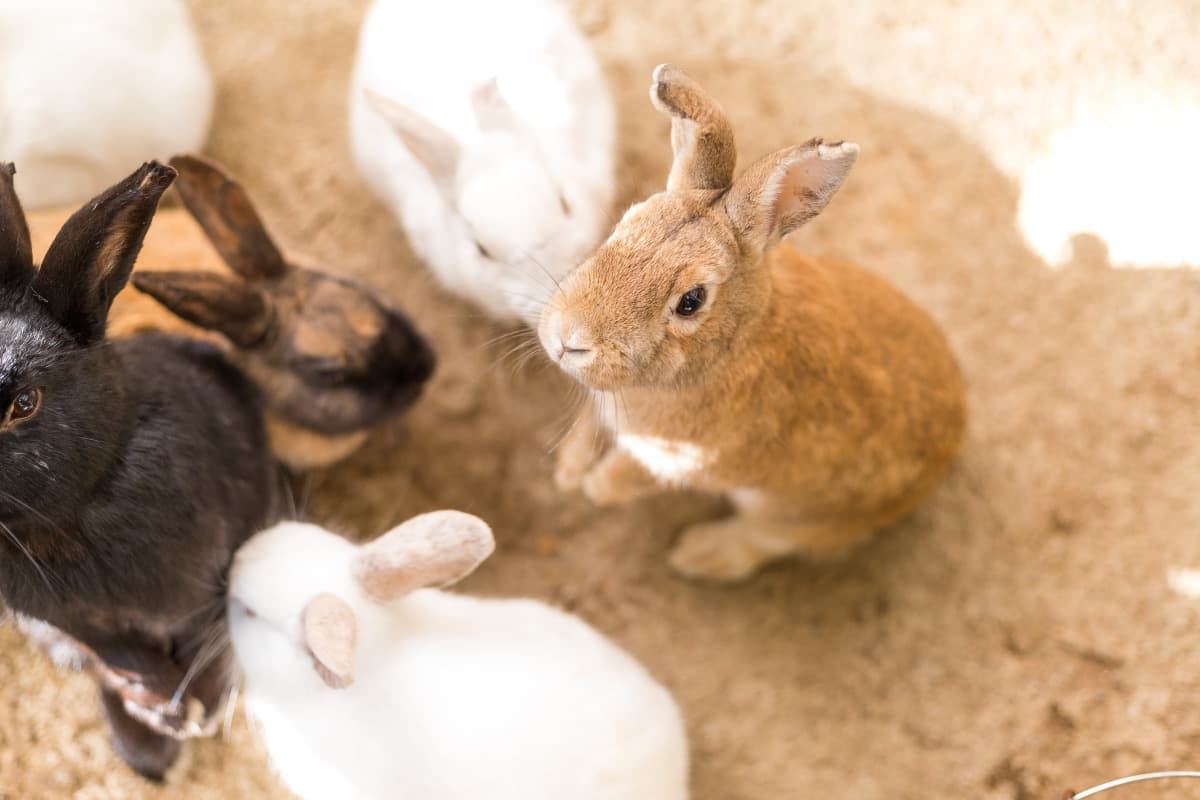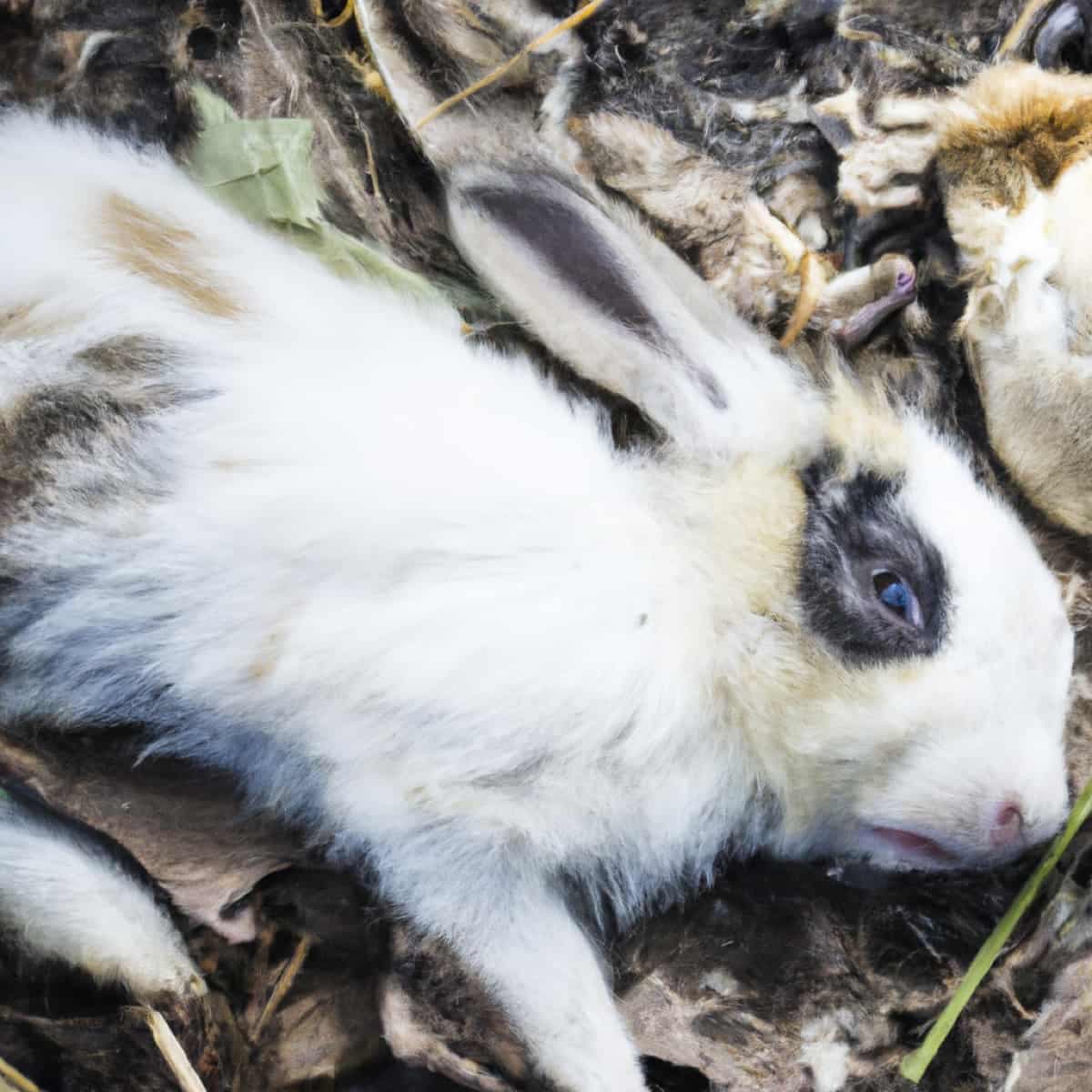Rabbits are an important source of meat and fur and are often raised in commercial production settings. However, like all animals, rabbits are susceptible to various diseases impacting their health and productivity. Below we learn about common rabbit diseases and treatment, prevention, and control measures for rabbit diseases.

Top 10 Rabbit Diseases
Rabbit Viral Hemorrhagic Disease (RVHD)
- Symptoms: fever, lethargy, loss of appetite, bloody discharge from nose or mouth, seizures, and sudden death
- Causes: a highly contagious virus that spreads through direct contact with infected rabbits, their feces or urine, contaminated surfaces or equipment, or insects like flies and mosquitoes
- Prevention: vaccination, biosecurity measures like disinfecting equipment, limiting visitors and movement of animals, and controlling insect populations
- Control: isolate and treat infected rabbits, cull severely affected or unresponsive rabbits, and implement strict biosecurity protocols
Pasteurellosis
- Symptoms: abscesses, respiratory problems, fever, lethargy, loss of appetite, and sudden death
- Causes: bacteria called Pasteurella multocida that can infect rabbits through wounds, bites, or inhalation of contaminated droplets
- Prevention: regular health checks, proper sanitation, avoiding overcrowding, and separating sick animals
- Control: treat with antibiotics, drain, and clean abscesses, and maintain good hygiene practices
Coccidiosis
- Symptoms: diarrhea, weight loss, lethargy, dehydration, and stunted growth
- Causes: a parasitic infection caused by coccidia that can be transmitted through fecal-oral contamination, ingestion of contaminated food or water, or contact with contaminated surfaces
- Prevention: regular cleaning and disinfection of cages and equipment, avoiding overcrowding, and providing clean food and water
- Control: treat with anti-coccidial drugs, improve hygiene practices, and isolate and cull severely affected animals
Encephalitozoonosis
- Symptoms: nervous system disorders, including head tilting, paralysis, and convulsions, as well as weight loss, anorexia, and diarrhea
- Causes: a parasitic infection caused by Encephalitozoon cuniculi that can be transmitted through urine or feces of infected rabbits or contaminated surfaces
- Prevention: good hygiene practices, regular cleaning and disinfection, and avoiding overcrowding
- Control: treat with anti-parasitic drugs, isolate and cull severely affected animals, and improve sanitation measures
Myxomatosis
- Symptoms: Swollen eyelids, fever, lethargy, loss of appetite, respiratory problems, and skin lesions
- Causes: a viral disease transmitted by fleas and mosquitoes, as well as direct contact with infected rabbits or contaminated surfaces
- Prevention: vaccination, flea and mosquito control, and avoiding contact with wild rabbits
- Control: isolate and treat infected animals, cull severely affected or unresponsive rabbits, and improve flea and mosquito control measures.
In case you missed it: Top 10 Quail Diseases: Symptoms, Causes, Preventions, and Control

Enterotoxemia (Clostridium sp.)
- Symptoms: sudden death, diarrhea, anorexia, lethargy, convulsions, and coma
- Causes: bacteria called Clostridium sp. produce toxins in the gut and can be triggered by dietary changes or stress
- Prevention: avoid sudden dietary changes, provide good quality feed, and minimize stress factors like overcrowding or poor ventilation
- Control: treat with antibiotics and supportive care, and improve management practices to reduce stress and prevent a recurrence.
Snuffles (Pasteurella multocida)
- Symptoms: sneezing, nasal discharge, conjunctivitis, and respiratory distress
- Causes: a bacterial infection caused by Pasteurella multocida that can be transmitted through the air, direct contact, or contaminated surfaces
- Prevention: regular health checks, proper sanitation, avoiding overcrowding, and separating sick animals
- Control: treat with antibiotics, improve hygiene practices, and isolate and cull severely affected animals.
Tularemia
- Symptoms: fever, lethargy, anorexia, respiratory problems, swollen lymph nodes, and skin lesions
- Causes: a bacterial infection caused by Francisella tularensis that can be transmitted through contaminated food or water, bites from infected insects or predators, or direct contact with infected animals
- Prevention: good hygiene practices, avoiding contact with wild animals, and controlling insect populations
- Control: treat with antibiotics, isolate and cull severely affected animals, and improve hygiene and biosecurity measures.
Ear Mites (Psoroptes cuniculi)
- Symptoms: scratching, head shaking, crusty ear discharge, and scaly skin
- Causes: a parasitic infection caused by Psoroptes cuniculi that can be transmitted through direct contact with infected rabbits or contaminated objects
- Prevention: regular cleaning and disinfection of cages and equipment, avoiding overcrowding, and minimizing contact with wild rabbits
- Control: treat with acaricides, improve hygiene practices, and isolate and cull severely affected animals.
Sore Hocks (pododermatitis)
- Symptoms: reddened, swollen, or ulcerated skin on the bottom of the feet, lameness, and reluctance to move
- Causes: a bacterial infection caused by poor hygiene, rough or abrasive surfaces, or excessive body weight
- Prevention: Provide clean and dry flooring, avoiding overcrowding, and proper sanitation
- Control: treat with antibiotics, improve housing and management practices to prevent a recurrence, and cull severely affected animals if necessary.
Frequently Asked Questions about Rabbit Diseases
How do You Control Rabbit Disease?
Controlling rabbit diseases requires a multifaceted approach that includes preventative measures, early detection, and timely treatment. One of the most effective methods of controlling rabbit diseases is good management practices, including maintaining a clean and hygienic environment, providing a balanced diet, and minimizing stress in the herd.
Vaccination is also an important tool in controlling specific diseases, and it should be administered according to a schedule recommended by a veterinarian. Early detection of diseases is crucial, and regular monitoring of the herd’s health can help identify any potential health issues before they escalate into a larger problem.
In case you missed it: Top 10 Shrimp/Prawn Diseases: Symptoms, Causes, Prevention, and Control

Timely treatment with appropriate medication or veterinary care is necessary to prevent the spread of disease and minimize the impact on the herd’s productivity. Additionally, implementing biosecurity measures, such as limiting access to the rabbitry, can help prevent introducing new diseases to the herd. Overall, controlling rabbit diseases requires a proactive and preventative approach, focusing on good management practices, vaccination, early detection, and timely treatment.
Conclusion
In conclusion, commercial rabbit production can be vulnerable to various diseases that can impact the health and productivity of the herd. Rabbit farmers must be aware of the top 10 diseases, their symptoms, causes, and prevention and control methods. By implementing good management practices, such as maintaining proper hygiene and sanitation, providing a balanced diet, and ensuring adequate ventilation, farmers can significantly reduce the risk of disease outbreaks.
Regular monitoring of the herd’s health and immediate veterinary attention can also help control and prevent disease spread. Overall, a proactive and preventative approach to rabbit health is essential in maintaining a successful and sustainable commercial rabbit production system.
- Feed Your Flock for Less: Top 10 Tips to Save on Chicken Feed
- Ultimate Guide to Ossabaw Island Hog: Breeding, Raising, Diet, and Care
- Hatching Answers: The Top 10 Reasons Your Chickens Aren’t Laying Eggs
- Eggs and Economics: Breaking Down the Cost of Raising Backyard Chickens
- Defend Your Greens: Proven Methods to Keep Iguanas Out of Your Garden
- Ultimate Guide to Cinnamon Queen Chicken: A Comprehensive Guide for Beginners
- Ultimate Guide to California Tan Chicken: Breeding, Raising, Diet, Egg-Production and Care
- Ultimate Guide to Marsh Daisy Chicken: Breeding, Raising, Diet, and Care
- 10 Types of Chicken Farming Businesses You Can Start for Profits